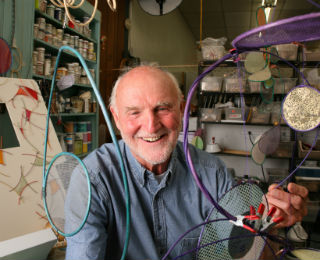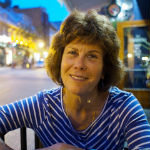Published: September 30, 2015
 Written By: Molly Kavanaugh
Written By: Molly Kavanaugh
As men and women age, loss and loneliness sometimes try to wedge a foot into their lives. But swirling a paintbrush, molding a piece of clay or participating in a sing-along can open their door to a joyful companion.
Professor Raquel Stephenson, who heads up Lesley University’s Art Therapy program, says research shows that making art with others can counteract many of the negative impacts of aging and promote increased self-esteem, motivation and social connection, leading to improved health and wellbeing.
“Older adults have a high capacity for creativity because they are willing to take risks,” she says. “When people take the risk of making art with others, it builds community, which is therapeutic. Making art allows this community-building to happen quickly and more powerfully.”
Solo art projects can be equally beneficial. When 78-year-old Peter Rinaldi underwent surgery for laryngeal cancer at Cleveland’s University Hospitals, he turned to abstract painting to help ease his pain and isolation.
"Imagine waking up and you are not able to talk, and you breathe through a hole in your throat," Rinaldi's wife, Kathy, told the Plain Dealer. She gets choked up when she talks about how much her husband’s engagement in art during the toughest times of his illness helped pull him through. "It was a godsend for him."
Arts Therapy Thrives at Kendal
Arts therapy is well known and widely practiced at Kendal at Oberlin. Under the dynamic Creative Arts Therapy team of Michele Tarsitano-Amato and Jara Dell, Kendal offers a full and diverse Activities Program for the skilled and assisted living residents of the Stephens Care Center. Both women hold master’s degrees - Michele in Art Therapy and Jara in Music Therapy.
Resident art projects include: a multi-colored stained glass wall hanging, “The Glass Garden of Friendship,” that hangs in the Friends Corner dining room in the Stephens Care Center; sun catchers that were presented to each founding resident and staff member for Kendal at Oberlin’s 20th anniversary in 2013; assorted crafts and handmade jewelry used to purchase a digital camera and kiln for making pottery.
When it comes to music, Jara explains what a typical day is like at Kendal.
“I always have a music group in the morning that lasts for an hour. During that time, I’ll sing and play various instruments while residents practice movements, or we’ll play different games with music. In the afternoons, we have all sorts of various things. We have sing-alongs. I run a bell choir group. In the past, we’ve done music history. When I can, I offer music therapy on a one-on-one basis where there’s the most need,” she explains.
The Benefits of Music Therapy for Older Adults
Research shows music therapy has a number of benefits for older adults, especially those with Alzheimer’s disease or other age-related mental health needs. A few key benefits include:
-
Improved memory and recall
-
Positive changes in mood and emotional states
-
Improved outlook on life and higher self-esteem
-
Better self and environmental awareness and concentration
-
Reduced tension and improved relaxation
-
Diminished pain and improved recovery time
-
Enhanced interest level and social interaction
-
Increased mobility and coordination
“A lot of times, music can reach people when nothing else can,” Jara says. “Music is like its own language, and it’s a language everyone can speak.”
The fact that Kendal at Oberlin offers creative arts health services like music therapy, is a major factor many older adults ultimately choose to relocate to the campus, Jara adds.
“When residents first move in, they’re usually moving into the independent living units versus the care center, but I definitely have people who live independently come to me and say, ‘I hope you’re still here if I need to come here,’” she says. “They see what a difference our program can make in people’s lives.”

 Written By: Molly Kavanaugh
Written By: Molly Kavanaugh



